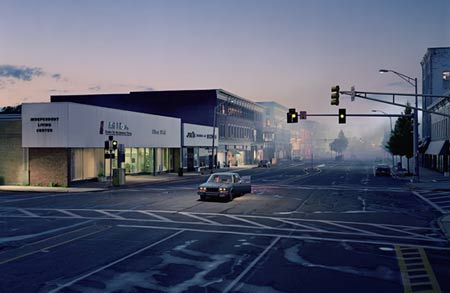New and Used

A common complaint about a photographer’s new work is that it’s a mere repetition of older work. As an illustration, I am using a photo from Gregory Crewdson’s new work, but that’s really just an arbitrary choice. I could have easily picked something from Andreas Gursky’s latest work, say - whose Chelsea show got attacked in the press for that very same reason: We’ve seen this before, we want something new.
In part, this problem arises because our culture is centered on excessive consumption - we can easily satisfy our material needs, but for “the economy” to function well (aka to grow) we have to consume things that we don’t need. Thus, we are constantly being told that the reason why we need something is because it is new and better. Being subjected to this in our daily lives just has to rub off and affect us. For example, I have a very old cell phone (which works perfectly well), but it does not have a camera built in, neither can it play mp3 files, and it doesn’t come with the automatic cool that Apple so successfully has turned into a marketing ploy for their overpriced gadgets. Even though I am very aware of the fact that I really do not need a new cell phone (and I also don’t need a camera in my phone, especially since I have a whole bunch of actual cameras), I constantly have to very consciously remind myself of what’s going on, when the part of my brain targeted by ads tells me my old phone sucks. But I’m digressing.
Ignoring the second part in “We’ve seen this before, we want something new” leaves us thus with the first part: We’ve seen this before. Is this good or bad? I think the answer is more complicated than it would seem, even though I can phrase it in a deceptively simple way: It depends.
I am not under the illusion I will be able to get to the bottom of all of this in a simple post on the blog, but I think it’s useful to disentangle two crucial aspects of this complex, which it is important to keep apart: I want to call the first one “style” and the second one “meaning” (or maybe “contents”).
By “style” I mean, very simply, the combination of the photographer’s way of work plus the end result. Note that there are photographers for whom defining a style is not that straightforward, but then I submit that for those we probably won’t hear the complaint discussed here. So for Gregory Crewdson we’d have a huge crew, an elaborately staged set (either constructed in a studio or a real setting outdoors), and a large-format camera with various exposures, which are then stitched together to create something that looks very unique: You’ll easily recognize a photo by Gregory Crewdson when you see one.
With “meaning” or “contents” I am trying to describe what the photos actually say, their intended message. Here, we are on more slippery territory, since it’s much harder to describe with words what this is. But for the sake of this discussion, I don’t even have to be able to put this down well, as long as it’s clear that the meaning/contents is quite separate from the style. (And let’s not kid ourselves: Some photography that looks very “cool” is very, very thin on actual meaning [I’d love to give some names here, but I’m in too good a mood for that]).
And it is the meaning or contents that I usually use to decide about whether I really want something new or not. If the style is the same, but there is a different meaning to a set of new photos, that’s quite different from a set of photos that just look like the old work and have nothing more/new to say. So when I get an email with the complaint “That’s boring, I’ve seen this before” (as happens occasionally) or (and this is an interesting variation) “XX’s photos are just like YY’s”, I look for what the photos are intended to say before writing back and agreeing or disagreeing.
After all, photographer YY might be able to take the technique pioneered by photographer XX and add just that little twist that elevates the technique and/or meaning into something better. I want to be open to that possibility. And if photographer ZZ decides to use her or his old technique yet again, there might be a very good reason for this, since s/he might want to investigate something different or look at things from a different angle. I want to be open to that possibility, too.
PS: As in the case of Andreas Gursky’s (and despite the hang-ups that so many people appear to have with his work), I personally have no problem with Gregory Crewdson’s new work. I quite like it - even though, on the surface, it has not changed what it looks like for a while now.